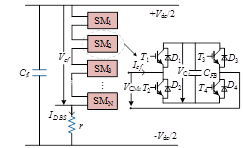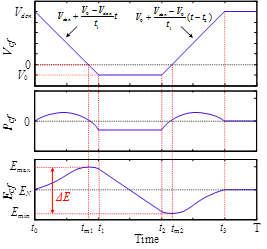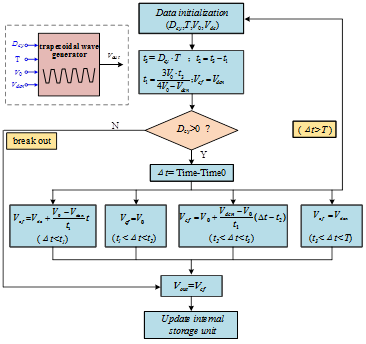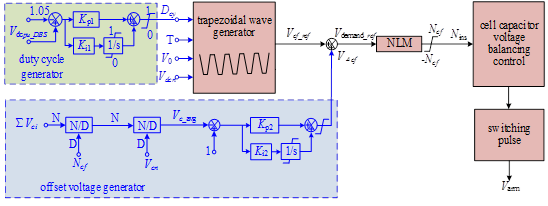0 导语
随着柔性直流输电技术的发展,MMC在陆上风电并网的应用日益广泛。为应对系统的交直流故障,本文提出了一种全控型耗能装置(FB-DBS),通过控制级联模块的输出电压吸收暂态不平衡能量。耗能装置仅需要本地检测信号,柔性接入减小了电流电压冲击,降低了对周围环境的电磁干扰。
Energy Dissipation of MMC-HVDC based Onshore Wind Power Integration System with FB-DBS and DCCB
Abstract:
With the development of HVDC, MMC is seeking its application in onshore wind power integration. AC and DC faults are important issues for the wind power inte-gration system, during which the wind generation system continuously provides wind power and the surplus power may cause overvoltage to sub-modules of MMC. This paper focuses on the energy dissipation during AC and DC faults for the overhead-line MMC-HVDC system integrating large scale wind power. A two-terminal MMC-HVDC system with permanent magnet synchronous generator (PMSG) based wind farm is studied. Hybrid DC current breakers (DCCBs) are employed to interrupt DC fault current and the method based on measuring the rate of change of DC line voltage is adopted to trip DCCBs. Also a full-bridge sub-module based dynamic braking system is implemented at the DC link to absorb the surplus wind power in case of AC or DC faults in the HVDC grid. To ride-through AC and DC faults without blocking IGBTs, the control of hybrid DCCB and the system fault ride-through (FRT) strategies are properly designed. PSCAD/EMTDC simulations are shown to demonstr-ate theoretical analysis.
1 项目背景
MMC-HVDC具备有功无功独立控制,控制方式灵活,且可以直接连接风电系统等优势,是风电并网的优选方案之一。对于MMC-HVDC风电并网系统而言,一旦交直流线路发生短路故障,功率无法传输到受端交流电网,风电能量会灌注到两侧MMC当中,引起子模块电容电压过高,危害电力系统的安全运行。
采用耗能装置吸收暂态能量是解决该问题的主要方法之一,但现有耗能装置方案的参数设计和控制策略都比较简单,耗散功率恒定,且在投切瞬间会造成较大的电流冲击。因此,目前急需一种能够满足能量耗散需求、灵活可控且能够平滑投退的耗能装置拓扑。
2 论文所解决的问题及意义
为解决MMC-HVDC风电并网系统的交直流故障穿越与能量耗散问题,提出了一种全桥型耗能装置拓扑,分析了其控制原理并提出了相应的参数设计方案。在混合型DCCBs的配合下,通过控制全桥级联模块的正负投入使耗能电阻逐步吸收能量,实现了耗能装置的平滑投退和动态灵活控制。
3 论文重点内容
1)风电并网系统及耗能装置结构
图1所示为典型的双端MMC-HVDC风电并网系统拓扑。风电场由若干个永磁直驱式风机(PMSG)组成。风电经过升压后传输至风场侧换流站(WFMMC),再经过远距离架空线传输到电网侧换流站(GSMMC),换流站均采用半桥型常规拓扑。正常运行时,风场侧换流站采用定交流电压控制,电网侧换流站采用定直流电压控制。图2为耗能装置的基本结构,其中全桥级联模块由FBSM串联组成,与耗能电阻r串联后并联在HVDC直流正负极间,Cfl为滤波电容。

图1 基于PMSG的MMC-HVDC风电并网系统

图2 耗能装置的结构
2)耗能装置运行控制策略
图3给出了级联全桥模块一个周期内的电压、功率和能量。根据输出电压Vcf的变化,一个周期可以分为四个阶段。第一阶段[t0, t1],级联全桥模块的输出电压线性下降到V0,迫使直流电流流过FB-DBS支路;第二阶段[t1, t2],级联FBSM保持输出电压V0(负值),使其释放能量;第三阶段[t2, t3],输出电压反向上升到Vdcn,至此一个周期的有效控制结束。[t3, T]为占空比所对应的空窗期,通过控制占空比可以控制FB-DBS的工作状态。
根据上述分析,耗能装置的运行需满足一个周期内全桥模块吸收和释放的能量总和为零。为简化计算,全桥级联模块输出电压按照等腰梯形进行调制,得到其调制算法如图4所示。
推导占空比和直流电压的关系、子模块电容电压波动与全桥模块输出电压的关系可以得到耗能装置的控制策略如图5所示。直流电压低于1.05pu时,占空比限幅为0;当直流电压超过1.05pu时,占空比快速上升至1,耗能装置启动;其中当子模块处于过压时,VΔcf为负,投入子模块数减小;子模块低于额定电压时,VΔcf为正,投入子模块数增加。

图3 级联全桥模块一个周期内的电压、功率和能量

图4 耗能电阻控制器的调制算法

图5 耗能装置的控制策略
3)系统交直流故障穿越与能量耗散策略
风电并网系统交直流故障穿越与能量耗散策略如图6所示。当电网侧发生交流故障时,直流电流低于额定值,直流断路器不会触发跳闸,只需耗能装置吸收多余的风电能量;如果发生直流故障,首先直流断路器迅速跳闸,隔离故障线路,然后耗能装置启动吸收多余的风电,经过200ms去游离后DCCB重合闸,系统恢复正常运行。

图6 风电并网系统交直流故障穿越与能量耗散策略
Conclusion
In this paper, an energy dissipation device, FB-DBS, is designed to absorb the surplus wind power during AC and DC fault in MMC-HVDC wind power integration system. Based on the analysis of the operating principle of FB-DBS, comprehensive control strategies and parameter design of the FB-DBS are proposed. The FB-DBS can operate without communication system for only local detection signals are in need, and the smoothly controlled di/dt and dv/dt bring a lower EMI to surroundings. A travelling wave method based on measuring the rate of change of line side DC voltage is adopted to trip hybrid DCCBs to interrupt DC fault current rapidly and correctly. Besides, the control of hybrid DCCB and the system FRT strategies during AC and DC faults are proposed. The simulation shows that FB-DBS can suppress the peak arm current within 1.5pu under the DC fault and maintain the DC link voltage in the range of 1.2pu under AC fault.
作者简介:
Shuai Cao, Wang Xiang, Xiaojun Lu, Weixing Lin, Kai Zhang, Jinyu Wen, and Xin Zhang
 |
Shuai Cao received his B.Eng. degree in electrical engineering in 2016 from Zhengzhou University, China, and he is currently working toward the Ph.D degree in Huazhong University of Science and Technology (HUST), China. In 2019, he is also a joint-Ph.d student in the school of EEE, Nanyang Technological University (NTU). His main research interests include MMC-HVDC, wind power integration and dc grids. |
 |
Wang Xiang (S’16-M’17) received his B.Eng. and PhD degrees both in electrical engineering from Huazhong University of Science and Technology (HUST), China in 2012 and 2017 respectively. He was a visiting student at the University of Aberdeen and the University of Strathclyde in 2014 and 2016 respectively. He was a research fellow at HUST in 2017 and 2018. Currently, he is a research associate with the University of Strathclyde. His main research interests include MMC-HVDC, high power dc/dc converters and dc grids. |
 |
Xiaojun Lu (M’19)received his B.Eng and Ph.D degree both in electrical engineering from Huazhong University of Science and Technology (HUST), Wuhan, China in 2013 and 2018, respectively. He is currently a post-doctor at HUST. His main research interests include modeling and stability analysis of VSC/MMC-HVDC and DC grids. |
 |
Weixing Lin (M’13) obtained his B.E. and PhD degrees in electrical engineering from Huazhong University of Science and Technology (HUST), China, in 2008 and 2014 respectively. He is currently the director of HVDC department at TBEA China Xinjiang Sunoasis Co. Ltd. His research interests lie in HVDC, MMC, dc-dc autotransformer, high power and dc grids.
|
 |
Kai Zhang received the B.S., M.S., and Ph.D. degrees from the Huazhong University of Science and Technology (HUST), Wuhan, China, in 1993, 1996, and 2001, respectively. He joined HUST as an Assistant Lecturer in 1996, and was promoted to a full Professor in 2006. He was a Visiting Scholar at the University of New Brunswick, Fredericton, NB, Canada, from 2004 to 2005. He has authored more than 60 technical papers. His current research interests include uninterruptible power systems, railway traction drives, modular multilevel converters, and electromagnetic compatibility techniques for power electronic systems. |
 |
Jinyu Wen (M’10) received his B.Eng. and Ph.D. degrees all in electrical engineering from Huazhong University of Science and Technology (HUST), Wuhan, China, in 1992 and 1998, respectively. He was a visiting student from 1996 to 1997 and research fellow from 2002 to 2003 all at the University of Liverpool, UK, and a senior visiting researcher at the University of Texas at Arlington, USA in 2010. In 2003 he joined the HUST and now is a Professor at HUST. His current research interests include renewable energy integration, energy storage application, DC grid, and power system operation and control.
|
 |
Xin Zhang received two Ph.D. degrees. He received the Ph.D. degree in Automatic Control and Systems Engineering from the University of Sheffield, U.K., in 2016 and the Ph.D. degree in Electronic and Electrical Engineering from Nanjing University of Aeronautics & Astronautics, China, in 2014. He was the Postdoctoral Research Fellow (2017.01 -2017.09) and Research Assistant (2008.09-2009.03) at the City University of Hong Kong and the Research Associate (2014.02 - 2016.12) at the University of Sheffield. Currently, he is an Assistant Professor at the School of Electrical and Electronic Engineering of Nanyang Technological University (NTU), where he is also the Cluster Director in Energy Research Institute @NTU. |